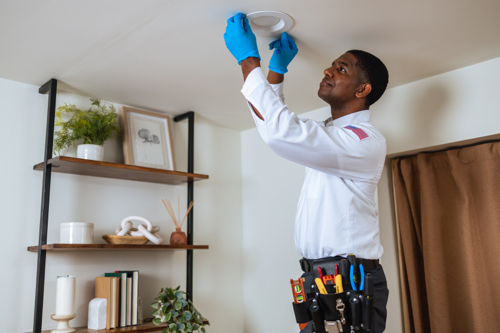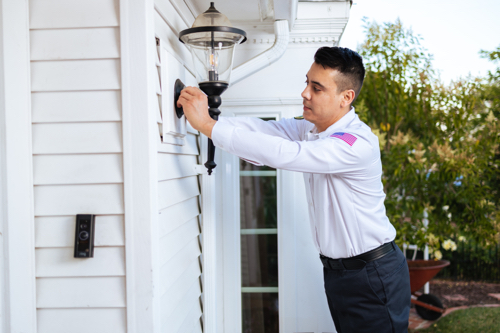 How Many Lumens Do You Really Need?
How Many Lumens Do You Really Need?
The lighting you use at home affects its ambience, functionality, and safety, whether you’re cooking, working, reading, or relaxing. Good lighting can help your space feel inviting and pleasant and make life easier, especially when you provide the right amount of illumination for each room. Below, we’ll discuss optimizing your lighting for particular areas, applications, and people in your home.
Understanding Lighting Terminology and Measurement
Good lighting design accounts for the amount of illumination a space requires and the needs, personal preferences, and ages of its occupants. When a space is well-lit, you’ll feel at ease and notice the objects and spaces the lighting illuminates, not the lamps or the fixtures themselves.
Understanding how to describe and measure light can help you supply the right amount of illumination for a particular area. Some common lighting design terms include:
- Lumens (lm): the amount of visible light a source, like a light bulb or the sun, emits or outputs
- Foot-candles (fc): denotes illuminance, or the light intensity on a surface, in lumens per square foot.
- Lux (lx): denotes illuminance in lumens per square meter.
Note: Americans typically use foot candles to measure illuminance, but they may also use lux. One foot-candle equals 10.764 lux, so if you need to convert lux to foot-candles, divide the number of lux by 10.764 to get the equivalent number of foot-candles.
Watts (W): A watt is the international standard unit for power that can be used to describe how much electricity a light bulb consumes.
Note: When incandescent bulbs were common, people associated watts (W) with brightness because bulbs that consumed more energy produced more light. A standard 60W incandescent bulb produces around 800 lm, while a 100-watt incandescent light bulb produces about 1,500-1,700 lm.
Modern LED bulbs use much less energy than incandescent bulbs to generate a relatively large amount of light; a 1000 lm LED bulb may consume 10 to 15 watts continuously, which is a fraction of the amount of power an equivalent incandescent bulb would use.
Today, most people care more about a bulb’s light output than the amount of energy it consumes, so modern light bulb packaging highlights the number of lumens the bulb produces. Different kinds of light sources, like LED, incandescent, fluorescent, and halogen bulbs, all have different lumen-to-watt ratios.
How Many Lumens Do You Need in Each Space?
When it comes to illuminating your home, the amount of light you need in a space depends on the type of room you’re in and what you’ll be doing there. Rooms like kitchens, where you might do detail-oriented tasks like preparing food, usually need more light than bedrooms or living rooms.
The Illuminating Engineering Society (IES), a society of professional lighting designers, provides a chart that describes how many foot-candles should shine on a surface to perform tasks comfortably in different types of spaces:
- Hallway: 5-10 fc
- Living Room: 10-20 fc
- Bedroom: 10-20 fc
- Dining Room: 30-40 fc
- Kitchen (General): 30-40 fc
- Kitchen (Tasks): 70-80 fc
- Bathroom: 70-80 fc
- Home office: 60-80 fc
- Workshop or garage: 80-100 fc
Note that this chart only tells you how bright your surfaces should be, not how much light you actually require to achieve that goal. Ultimately, the amount of light you need in a space depends on its size, shape, purpose, and the occupants’ needs.
To calculate the foot-candle requirements for a particular space, follow these steps:
Calculate the square footage of the room or space you plan to illuminate.
Consult the IES’s residential lighting chart to determine how many foot-candles a particular space requires.
Multiply the room’s area in square feet by the recommended number of foot-candles to approximate the total amount of light (in lm) you’ll need in the space.
For instance, if you have a 100 square foot bathroom, you’ll need 7000 lm to 8000 lm in the space (100 sq ft x 70 to 80 fc = 7000 lm to 8000 lm.)
You’ll also need to account for:
Your Personal Preferences
If your lighting feels too harsh, install dimmers to get the level of illumination you need. If you want the room to be brighter, use higher-intensity light bulbs or add lamps and other fixtures to the room.
Specific Tasks and Needs
If you’re writing, using tools, reading, or cooking and your work surface is too dim, use targeted task lighting to brighten that area.
Ceiling Heights
If you have ceilings that are 10 feet or higher, you’ll need to add extra lamps, use brighter bulbs, or use low-hanging pendant lights to distribute light where you need it.
Dark Paints, Finishes, and Furnishings
Dark colors and shades can absorb light, so if you use hues like brown, navy, eggplant, charcoal, or forest green for your walls, rugs, ceilings, or furniture, you may need to double, triple, or quadruple the light requirement you originally calculated for that room.
Ages of the Room’s Occupants
Older adults over 65 may need double the amount of light in a particular space to enhance its visibility.
Other Considerations: Balancing Ambient, Task, and Accent Lighting
Once you have a baseline estimation for the number of lumens you’ll need in a room, you can start planning to enhance the aesthetic and functionality of that space with ambient, task, and accent lighting.
- Ambient Lighting: To provide general illumination for a room, use floor lamps and ceiling fixtures.
- Task Lighting: When you need focused light for specific activities, you’ll need to provide targeted illumination with task lamps, under-cabinet lights, and pendant lamps.
- Accent Lighting: Add decorative lighting, like wall sconces or figurative table lamps, to highlight architectural features or artwork in your home.
Optimizing the Position of Your Lighting
Using different types of lighting simultaneously, like floor and table lamps, ceiling fixtures, recessed lighting, task lighting, and accent lighting, helps you create balanced layers of illumination.
To ensure that you always have the amount of light you need where you need it, make the most of dimmers and task lamps. Also, be sure to place lights near walls and directly over work areas to achieve ideal light distribution.
The Importance of Color Temperature and a Lamp’s Color Rendering Index
As you’re working out how to illuminate your home, remember to consider how the color temperature (measured in Kelvin, or “K”) and color rendering index of your light bulbs will affect how your space feels and functions.
Warm light at 2700K-3000K provides relaxing illumination that’s good for living rooms, dining rooms, and bedrooms. Neutral light at 3500K-4100K is ideal for kitchens, home offices, and bathrooms, while cool light at 5000K-6500K has an energizing quality that is best suited for task-focused workshops and garages.
The color rendering index (CRI) describes how accurately a light bulb will reveal the colors of an object; the higher the number on a scale of 100, the more realistic your colors should look.
Trust Mister Sparky for All Your Lighting and Electrical Needs
Understanding how many lumens you need in a room is key to making your home lighting comfortable, functional, and beautiful. If you want to enhance your lighting by adding new fixtures , or you want advice on making your lighting more practical and energy-efficient, the experts at Fort Myers Mister Sparky can help. For the best lighting and electrical services in Florida, don’t put up with any malarky; call Mister Sparky today!
